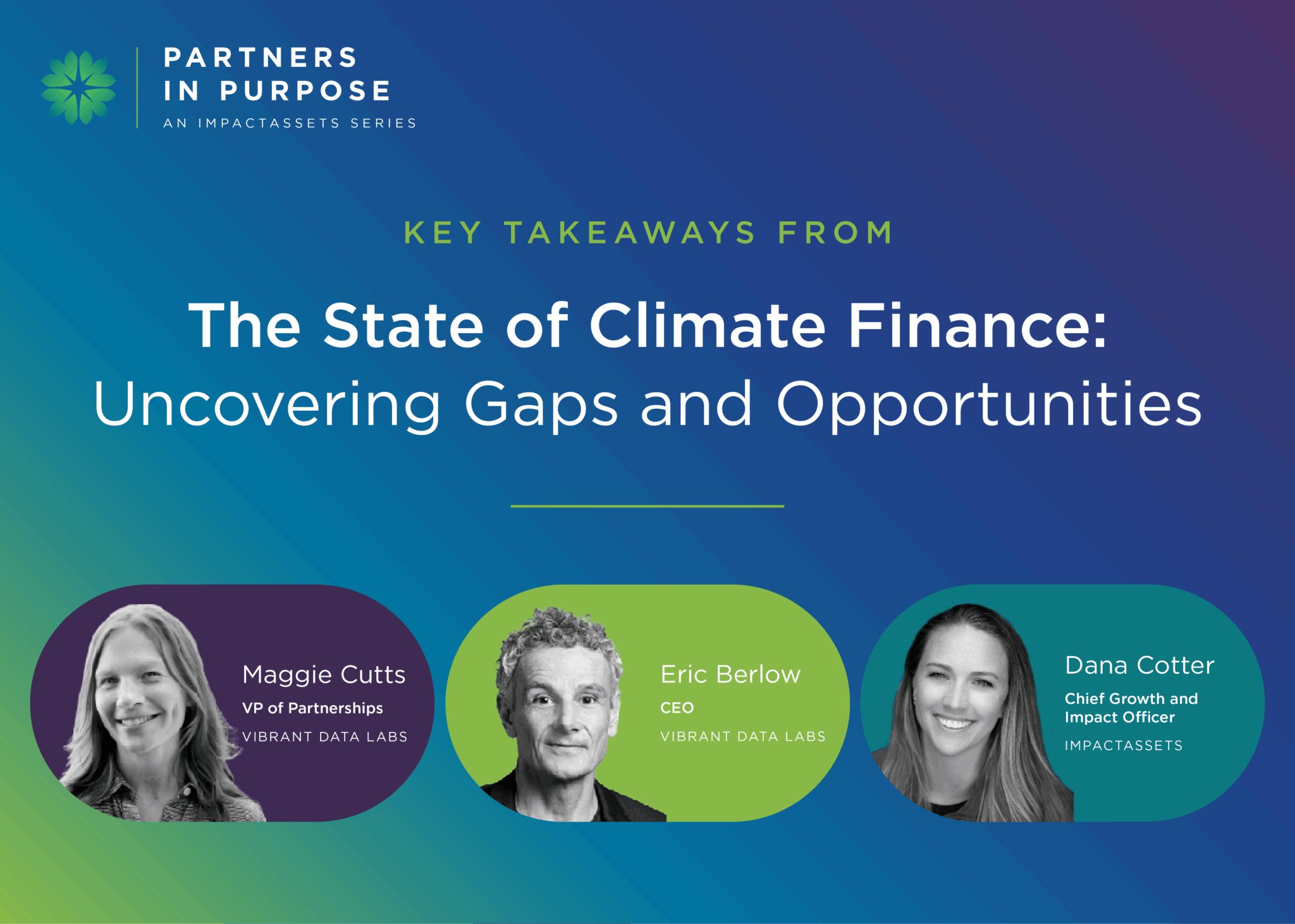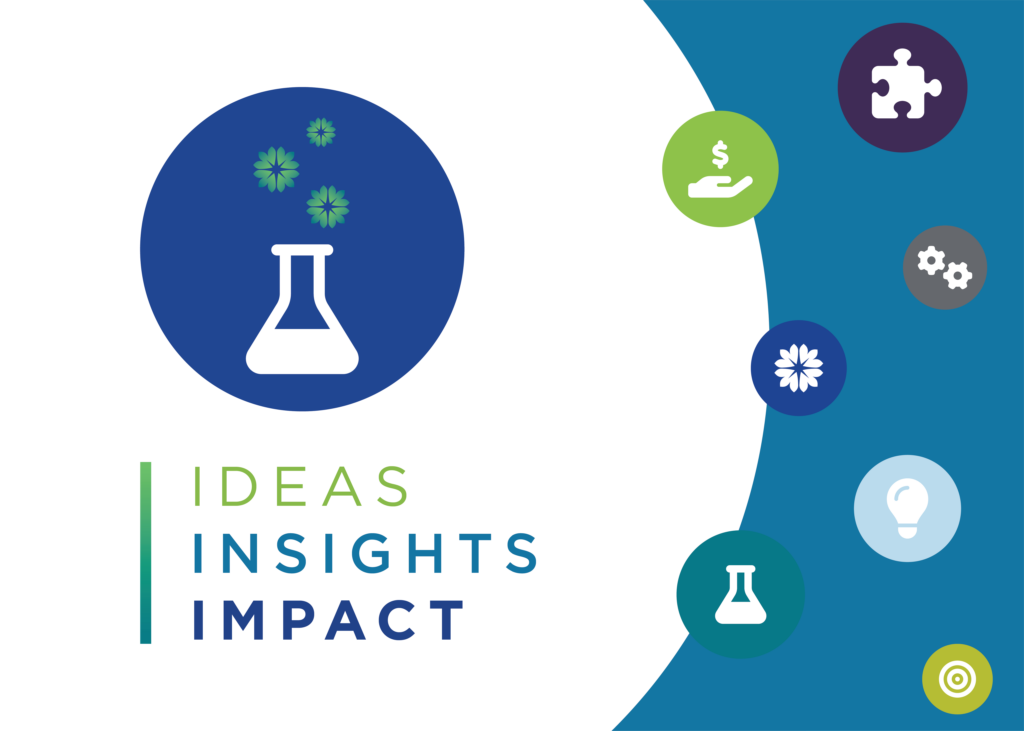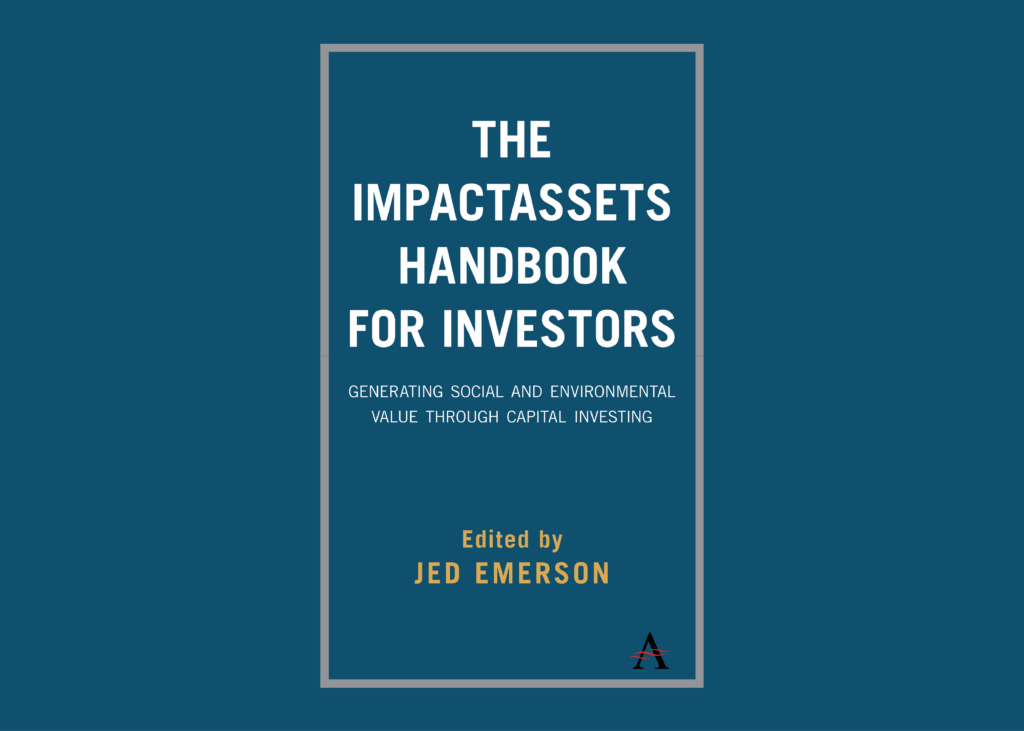Funding for climate solutions has gained momentum in recent years, having doubled between 2018 and 2022 to reach about $1.5 trillion, according to the Climate Policy Initiative.
Yet there’s an under-discussed problem lurking beneath this ramp-up—and it’s not only that the investment must still increase dramatically. As capital flows into climate finance strengthen, their paths and concentrations across solutions remain largely unmapped. The result is a frustrating lack of visibility for climate funders eager to adopt a strategic and tactical approach to creating impact — particularly by focusing on underfunded areas.
“To be effective at filling some of these key [climate financing] gaps, we need to understand where funding is flowing, where it’s not, and what the opportunities are for folks of all investor archetypes,” said Dana Cotter, Chief Growth and Impact Officer at ImpactAssets. “While we have made progress, we need so many more investors, structures, and tools to meet this moment we’re in.”
The webinar presented an opportunity to take a close look at one tool in particular that offers an answer to the opacity problem in climate funding: the public Climate Finance Tracker (CFT) created by Vibrant Data Labs.
The CFT helps investors of all stripes leverage data insights to make sense of climate capital flows and focus on climate solutions where their support is the most catalytic and impactful.
Over the course of their discussion, Cotter, Berlow, and Cutts covered the why, what, and how of approaching climate-focused funding with the benefit of the Climate Finance Tracker’s insights.
Why Mapping Capital Flows to Climate Matters
Berlow has drawn on a background in ecology, computational statistics, complexity science and network theory as he has overseen the development of the Climate Finance Tracker. In his current work—partnering with socially-driven companies, organizations, investors, and philanthropists using data to sharpen their funding decisions—he sees many similarities to complex biological ecosystems.
“If you connect the dots between who eats whom, you get what’s called a ‘food web,’ which reveals the architecture of how energy flows in real-world systems,” Berlow explained. “With the Climate Finance Tracker, we are trying to track who funds whom rather than who eats whom. But the statistics and methods are pretty similar.”
Berlow said that as he and his team at Vibrant mapped these complex climate-funding webs, they started to notice that “the money tends to be concentrated around a few shiny things.” And he knows all too well that in any interdependent, web-like system, collapse is inevitable if energy isn’t flowing readily to all the places it’s required. His prognosis for the climate financing ecosystem is no different.
“Honestly, from a complex systems perspective, we’ll have a big problem if we don’t fill all the gaps, because there’s a lot to do and it all needs to be done,” he said.
Considerations Funders Should Keep in Mind
It’s worth highlighting some good news about climate, he said: There’s a clear consensus around the necessary steps forward.
“Compared to any other complex problem I’ve worked on or can think of, climate is remarkable in the degree to which the solutions are so well defined,” Berlow said.
Research initiatives like Project Drawdown, One Earth, Speed and Scale, and the International Energy Agency’s Net Zero by 2050 reports have laid out solutions pathways that are in broad alignment with one another.
Berlow reported that his data has shown that as climate discussions shifted about a decade ago from a focus on ‘is climate change real?’ to ‘what do we do about it?,’ funding to the area increased precipitously year over year.
That’s a positive step. But, he cautioned, it’s not enough: the collective impact of this funding can’t be maximized unless it is tracked—so smart investors can “mind the gaps,” he explained. After all, not all funding gaps are equal.
“Different types of money may be better for different types of gaps,” he said. “Some gaps exist because there is no, and maybe never will be, a market solution. In other cases, there could be a market, but it’s too early or too high-risk.”
In other words, he said, funding gaps exist all across the climate ecosystem—and no matter the type of money a funder has to deploy (whether a market-rate-seeking investment, a loan, a grant, etc.), there’s a place where it’s badly needed. This insight may land as particularly relevant for philanthropic funders, given the flexibility of funding solutions within vehicles like Donor Advised Funds.
For instance, Vibrant’s Maggie Cutts explained that research with one of their investor partners revealed that early-stage companies’ survival rates were twice as high if they received a loan at some point in the venture-funding cycle—indicating that loans may have an under-appreciated role to play.
Berlow added that another stream of research revealed that roughly 25% of all the climate companies in the Climate Finance Tracker had a government funder at one stage of their life, with a median grant size of roughly $250,000. As this type of funding contracts under the current Administration in the U.S., private funders can step in to fill this critical gap.
“The private sector and philanthropy can step in to support early-stage innovation in a way that the government has been doing,” Berlow says. “That feels to me like something really doable.”
Leveraging the Climate Finance Tracker to Fill Gaps
To spotlight underfunded gaps in climate finance, the Vibrant team started with the One Earth Solutions Framework, which boils down three main solution pillars: 1) achieving 100% renewable energy and mobility; 2) protecting and restoring half of the world’s terrestrial and coastal ecosystems; and 3) reaching net-zero food and fiber production.
“Currently, in this and every other solution roadmap, nobody knows how much or what kind of money is going to each area,” Berlow said. “We can’t fund neglected solutions if we can’t see them, so that is the gap we’re trying to fill with the Climate Finance Tracker.”
The current version of their tracker compiles over $370 billion from over 14,000 investors and donors to over 10,000 U.S.-based climate-relevant companies and nonprofits.
Combing through this data revealed clear imbalances: for example, over 80% of the total funding was venture capital going to energy and mobility. By contrast, a paltry 1% of all funding flowed to the equally important area of nature conservation.
Climate-engaged funders considering the many glaring gaps could easily become overwhelmed, Berlow and Cutts acknowledged. When diving into the Tracker data, Cutts offered advice to keep in mind:
“Keep it simple,” she said. “What do you care about? What’s one area to want to deep-dive into? And then, how do your actions show up in the broader funding patterns?"
Guided by that framework, funders can use the Tracker tool to reveal which companies and nonprofits are working across each solution area, and who’s currently funding them—so that those interested in either direct investments or fund investments can access promising partners.
“So, for example, instead of shopping for shoes on Zappos, you can shop for positive deviants in the energy space that are, say, working to increase access to low-income communities—and their funders,” Berlow said. “Who’s doing the work, and who’s funding them?” With those connections made clear, climate funders can then easily opt to join in.
About Vibrant Data Labs
Vibrant’s mission is to increase the impact of climate finance by supporting funders and field-builders with public and open-source data tools that empower discovery, insights, and action. Vibrant utilizes data and a rigorous scientific process to analyze, contextualize, and make sense of the complexity of the climate solutions space.
Over the next year, Vibrant will expand its climate finance tracking capabilities to increase their geographic coverage, capital types, and user features. Stay tuned for more updates at Vibrant Data Labs.
LEGAL AND PROGRAM DISCLAIMER: This is not a solicitation to buy or sell securities, nor a private placement offering pursuant to any private placement memorandum that must be issued to qualified investors.






